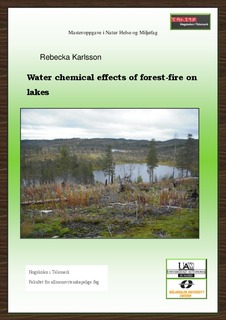| dc.contributor.author | Karlsson, Rebecka | |
| dc.coverage.spatial | Mykland | |
| dc.coverage.spatial | Aust-Agder | |
| dc.date.accessioned | 2013-02-05T08:45:03Z | |
| dc.date.accessioned | 2017-04-19T13:13:41Z | |
| dc.date.available | 2013-02-05T08:45:03Z | |
| dc.date.available | 2017-04-19T13:13:41Z | |
| dc.date.issued | 2012 | |
| dc.identifier.citation | Karlsson, R. Water chemical effects of forest-fire on lakes. Master thesis, Telemark University College / Universidad Autonoma de Madrid / Mälardalen University, 2012 | |
| dc.identifier.uri | http://hdl.handle.net/11250/2438914 | |
| dc.description.abstract | A fire occurred in Mykland, Froland municipality, southern Norway in June 2008. This study is analyzing long and short-term changes in water chemistry in 6 lakes within the burned catchments and 3 outside the burned area during 3 post-fire years. It is known that forest fires can lead to temporary acidification. The area has previous been acidified by long range transported air pollutants, this study evaluate if the fire caused chemical acidification effects. Other studies have observed increases of both cations and anions in surface waters after fire events. The study shows that the lakes were heavily acidified, due to larger increase of anions relative to cations after a large rain event two months after the fire. Accordingly the acid neutralizing capacity (ANC) of the lakes dropped significantly. The spread of dust and ashes after the fire might have caused changes in the reference lakes outside the fire area. The fire caused elevated concentration in K+ in burned lakes which likely is linked to its high abundance in biological material; the concentration was near pre-fire levels in the end of the third post-fire year. TOC decreased substantially after the fire, and then increased during all the three post-fire years. The concentration of SO42- had a large increase during the first post-fire year in the lakes with burned catchments, but showed significant decreases in all lakes during the next coming years, which might be linked to the general decrease of SO42- in this region, or to atmospheric fallout of ash from the burned catchments. It cannot be ruled out that ANC might be higher in the third post-fire year than before the fire. | |
| dc.language.iso | eng | |
| dc.publisher | Høgskolen i Telemark | |
| dc.subject | lakes | |
| dc.subject | forest fires | |
| dc.subject | water chemistry | |
| dc.title | Water chemical effects of forest-fire on lakes | |
| dc.type | Master thesis | |
| dc.description.version | Published version | |
| dc.rights.holder | © Copyright The Author. All rights reserved | |
